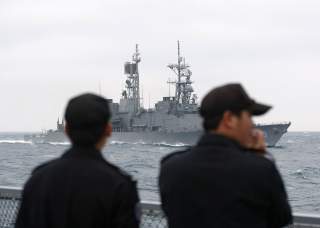Storm Clouds Are Gathering over the Taiwan Strait
Washington would do well to stop provoking China’s ire on Taiwan, lest it trigger a “Cuban Missile Crisis” in reverse.
The fate of the Taiwan Air Force is not a minor issue, of course. It is certainly correct that air superiority would be a key enabling factor for a Chinese amphibious attack. The author of the International Security study projects that Taiwan would be able to add fifty thousand soldiers per day against a PLA lodgment by road, rail and aircraft. But this assumes that Chinese air and missile forces have not cut these links and made movement around the island exceedingly difficult—a top priority mission and well within the grasp of the PLA today. Like many such analyses, moreover, this author tends to regard amphibious invasion as nearly impossible to pull off, citing that the United States suffered huge losses at Normandy. He seemingly downplays the fact that decisive amphibious campaigns occurred at Inchon in the Korean War (despite forbidding tides and coastal terrain) and during the Falklands War. Even at Normandy, most of the beach landings (Gold, Sword, Juno, Utah) were basically uncontested. More important still, the author also does not consider that modern amphibious assault is mainly undertaken through the use of helicopters (in three dimensions) rather than simply employing landing craft. Given that the PLA has been working on this attack plan for at least a decade, and especially (as related above) since 2014, this is a major omission and likely reflects the glaring paucity of actual Chinese sources in this research.
Regrettably, the discussion of a blockade scenario is not any more reliable. For instance, the author depends on a study from 2004 (also published in International Security) to claim that the Chinese Navy could sink just 1 to 6 percent of Taiwan shipping in a blockade. Yet that claim was thoroughly unconvincing when it was made back in 2004. Almost fifteen years later (and in light of very rapid PLA modernization) it is downright farcical. The author relies on a much more current study (2015) to claim that U.S. submarines could devastate a PLA amphibious invasion with few losses. However, that estimate was also badly flawed for numerous reasons, but particularly because it failed to explain how U.S. submarines could penetrate minefields laid by the PLA on either side of the Taiwan Strait to create a protective cordon for the amphibious armada. Of course, that armada would be comprised not only of tens of thousands of fishing boats, but also thousands of merchant vessels as well—another factor ignored in this study but very much an integral part of Chinese plans. The author of this new International Security study turns out to be quite correct in stating that “China is not poised to overrun maritime East Asia.” However, that is not because the Middle Kingdom lacks for the requisite military might—it does not. Rather, it is because China is actually not seeking military conflict with its neighbors, nor even with Taiwan. In other words, Beijing’s intentions, even within the maritime sphere, are reasonably benign.
American strategists may want to strive harder to attain an objective understanding of the military balance in the western Pacific. That might involve concerning themselves a bit less with the supposed threat of Chinese “influence campaigns” or with the even more bizarre “issue” of whether Burkina Faso, Gambia and Panama might switch recognition to Beijing from Taipei. Indeed, the U.S. foreign-policy establishment is rather badly in need of a reality check when it comes to Taiwan. First, China has a decisive geographic advantage in this scenario and thus massive conventional superiority that cannot be ignored or simply wished away. Second, the vast majority of Americans could not find Taiwan on a map of the world and this forms a major predicament for the myriad Washington elites, who have somehow developed an impassioned affection for the “beautiful island.” In combination, these two decisive aspects of the current crisis suggest the imperative for both extreme caution and also pragmatic attempts to steer cross-Strait relations back onto a cooperative path.
Most fundamentally, a core plank of the still evolving “America first” doctrine ought to be the principle of avoiding pinning the United States down, both diplomatically and militarily, within other people’s complex, family quarrels on the other side of the planet. Taiwan is emphatically not a “core interest” of the U.S. and Chinese leaders are all too aware of that glaring truth.
Lyle J. Goldstein is a research professor in the China Maritime Studies Institute at the United States Naval War College in Newport, RI. In addition to Chinese, he also speaks Russian and he is also an affiliate of the new Russia Maritime Studies Institute at Naval War College. You can reach him at [email protected]. The opinions in his columns are entirely his own and do not reflect the official assessments of the U.S. Navy or any other agency of the U.S. government.
Image: Navy personnel watch a Kidd-class destroyer sailing during a naval exercise outside a navy base in Zuoying, Kaohsiung, southern Taiwan January 21, 2011. REUTERS/Pichi Chuang (TAIWAN - Tags: MILITARY)

